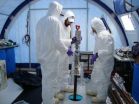(Press-News.org) What happens when the modern evolutionary theory of punctuated equilibrium collides with the older theory of mosaic evolution? Part of the answer comes from a new, wide-ranging study by paleobiologists Melanie J Hopkins at the Museum fuer Naturkunde Berlin and Scott Lidgard at the Field Museum in Chicago. Their results are published this week in the Proceedings of the National Academy of Sciences (PNAS).
While processes of evolution are largely studied by observation and experiment in the living world, evolutionary tempo and mode – rates and patterns of change, respectively – are mostly revealed by studying the fossil record. Paleontologists measure parts of the hard skeletal fossil remains of once-living organisms that they believe best represent the morphology, or form, of those organisms. They then analyze the variation in these traits through successive layers of rock that were laid down over longs spans of geologic time in order to determine the tempo and mode of species evolution. Punctuated equilibrium postulates that most evolutionary change takes place in relatively short periods of time during the origination of new species, while species themselves mostly undergo stasis, or little change, over longer periods. Several recent studies have indicated that stasis is much more common than gradual directional change in the fossil record. Mosaic evolution, on the other hand, is the tendency for different parts within species to evolve in different ways or at different rates.
The new study is based on data taken from hundreds of sequences of fossil samples previously reported in the scientific literature, but uses model selection methods available only in the last several years. The researchers compared models describing different modes of change, namely stasis, random change, and directional change, to each fossil series and found that different traits generally showed different, conflicting evolutionary modes within the same species. Many kinds of life were represented, including mammals, fish, mollusks, arthropods, and single-celled organisms. This large comparative study validates the ubiquity of mosaic evolution. However, it also raises questions about the evidence for different evolutionary modes, since the great majority of previous studies that quantify stasis, punctuated equilibrium, and gradual or "random" patterns in the fossil record are based on measurements of single traits, not on combined analyses of many traits. Further research will be required to establish the underlying processes driving the patterns of mosaic evolution and fossil species change. Nonetheless, the study is an excellent example of an emerging revolution in scientific inquiry as new techniques are used to breathe new life into old data.
### Contact:
Melanie J Hopkins, Museum für Naturkunde Berlin, +49 (0) 2093 8576, melanie.hopkins@mfn-berlin.de
Scott Lidgard, Field Museum of Natural History Chicago, +1 312 665 7625, slidgard@fieldmuseum.org
Field Museum Public Relations Office: media@fieldmuseum.org
(Note: Due to the Thanksgiving holiday, the PR office will be closed Nov. 22 and 23.)
Press embargo and preprints of the paper:
The press embargo on this paper will lift on November 26, 2012 at 3pm U.S. Eastern time. The embargo date is the earliest possible date that the article can publish. It is scheduled to appear online in the PNAS Early Edition in the week of November 26, 2012. An electronic preprint of the paper, "Evolutionary mode routinely varies amongst morphological traits within fossil species lineages," will be available to journalists starting Wednesday, November 21, 2012, on a secure PNAS reporters-only web site. The PNAS News Office may be contacted at pnasnews@nas.edu or 202-334-1310.
Evolutionary mode routinely varies amongst morphological traits within fossil species lineages
A new twist on the evolution of species
2012-11-27
ELSE PRESS RELEASES FROM THIS DATE:
Preventive screening for sudden cardiac death in young athletes debated
2012-11-27
While ensuring the safety of high school and college athletes is hardly controversial, the method and associated costs of doing so are hotly debated. Conducting electrocardiographic (ECG) screenings of all young competitive athletes in the United States would cost up to $69 billion over 20 years and save about 4,813 lives, making the cost per life saved over $10 million, according to a study published online today in the Journal of the American College of Cardiology.
A corresponding editorial suggests that this number is inflated and "misleading" and blames the high ...
Exposure to traffic pollution in pregnancy, first year of life appears associated with autism
2012-11-27
CHICAGO – Exposure to traffic-related air pollution, particulate matter and nitrogen dioxide during pregnancy and during the first year of a child's life appears to be associated with an increased risk of autism, according to a report published Online First by Archives of General Psychiatry, a JAMA Network publication.
Autism is a diverse disorder with genetic and environmental factors likely contributing to its origins. Autism spectrum disorders are commonly characterized by problems in communication, social interaction and repetitive behaviors. Emerging evidence suggests ...
Study suggests eliminating Medicare consultation payments associated with a net increase in spending
2012-11-27
CHICAGO – A study of Medicare claims data suggests that eliminating payments for consultations commonly billed by specialists was associated with a net increase in spending on visits to both primary care physicians and specialists, according to a report published Online First by Archives of Internal Medicine, a JAMA Network publication.
Before 2010, Medicare payments for consultations were substantially higher than for office visits of similar complexity that were commonly billed by primary care physicians (PCPs). In January 2010, Medicare eliminated consultation payments ...
Automated phone and mail notices increase medication adherence
2012-11-27
PASADENA, Calif., Nov. 26, 2012 — Patients newly prescribed a cholesterol-lowering medication were more likely to pick it up from the pharmacy if they received automated phone and mail reminders, according to a study published in the Archives of Internal Medicine today. This is one of a few published studies to examine strategies for reducing primary nonadherence, which occurs when patients do not pick up new prescriptions.
The study of 5,216 Kaiser Permanente Southern California patients found that those who received an automated reminder were 1.6 times more likely ...
Shrubs lend an insight into a glacier's past
2012-11-27
The stems of shrubs have given researchers a window into a glacier's past, potentially allowing them to more accurately assess how they're set to change in the future.
Their findings have been published today, 27 November, in IOP Publishing's journal Environmental Research Letters, and show how a glacier's history of melting can be extended way past the instrumental record.
Much like the rings on a tree stump indicate how old it is, measuring the width of rings on the stem of a shrub can give a good indication of how well it has grown year on year. Under extreme environmental ...
Scientists image brain structures that deteriorate in Parkinson's
2012-11-27
CAMBRIDGE, MA -- A new imaging technique developed at MIT offers the first glimpse of the degeneration of two brain structures affected by Parkinson's disease.
The technique, which combines several types of magnetic resonance imaging (MRI), could allow doctors to better monitor patients' progression and track the effectiveness of potential new treatments, says Suzanne Corkin, MIT professor emerita of neuroscience and leader of the research team. The first author of the paper is David Ziegler, who received his PhD in brain and cognitive sciences from MIT in 2011.
The ...
Using biomarkers from prehistoric human feces to track settlement and agriculture
2012-11-27
For researchers who study Earth's past environment, disentangling the effects of climate change from those related to human activities is a major challenge, but now University of Massachusetts Amherst geoscientists have used a biomarker from human feces in a completely new way to establish the first human presence, the arrival of grazing animals and human population dynamics in a landscape.
Doctoral student Robert D'Anjou and his advisor Raymond Bradley, director of the Climate System Research Center at UMass Amherst, with UMass colleagues Nick Balascio and David Finkelstein, ...
This week's forecast: Sunny with a 40 percent chance of flu
2012-11-27
NEW YORK (November 26, 2012)—Scientists have developed a system to predict the timing and severity of seasonal influenza outbreaks that could one day help health officials and the general public better prepare for them. The system adapts techniques used in modern weather prediction to turn real-time, Web-based estimates of influenza infection into local forecasts of seasonal flu.
Results appear online in the Proceedings of the National Academy of Sciences.
Year to year, and region to region, there is huge variability in the peak of flu season, which, in temperate areas ...
New hope for setback-dogged cancer treatment
2012-11-27
Several drugs companies have ineffectively tried to produce antibodies that bind to the IGF-1 receptor on the cell surface, which has a critical part to play in the development of cancer. Scientists at Karolinska Institutet in Sweden have now ascertained how these antibodies work, and can explain why only some cancer patients are helped by IGF-1 blockers during clinical tests. The researchers also present a means by which drugs of this kind could help more cancer patients.
Every cell contains thousands of tiny receptors that help it communicate with other cells. These ...
Ancient microbes found living beneath the icy surface of Antarctic lake
2012-11-27
RENO – This week a pioneering study published in the Proceedings of the National Academy of Sciences (PNAS) and co-authored by Dr. Alison Murray and Dr. Christian Fritsen of Nevada's Desert Research Institute (DRI) reveals, for the first time, a viable community of bacteria that survives and ekes out a living in a dark, salty and subfreezing environment beneath nearly 20 meters of ice in one of Antarctica's most isolated lakes.
Lake Vida, the largest of several unique lakes found in the McMurdo Dry Valleys, contains no oxygen, is mostly frozen and possesses the highest ...
LAST 30 PRESS RELEASES:
Numbers in our sights affect how we perceive space
SIMJ announces global collaborative book project in commemoration of its 75th anniversary
Air pollution exposure and birth weight
Obstructive sleep apnea risk and mental health conditions among older adults
How talking slows eye movements behind the wheel
The Ceramic Society of Japan’s Oxoate Ceramics Research Association launches new international book project
Heart-brain connection: international study reveals the role of the vagus nerve in keeping the heart young
Researchers identify Rb1 as a predictive biomarker for a new therapeutic strategy in some breast cancers
Survey reveals ethical gaps slowing AI adoption in pediatric surgery
Stimulant ADHD medications work differently than thought
AI overestimates how smart people are, according to HSE economists
HSE researchers create genome-wide map of quadruplexes
Scientists boost cell "powerhouses" to burn more calories
Automatic label checking: The missing step in making reliable medical AI
Low daily alcohol intake linked to 50% heightened mouth cancer risk in India
American Meteorological Society announces Rick Spinrad as 2026 President-Elect
Biomass-based carbon capture spotlighted in newly released global climate webinar recording
Illuminating invisible nano pollutants: advanced bioimaging tracks the full journey of emerging nanoscale contaminants in living systems
How does age affect recovery from spinal cord injury?
Novel AI tool offers prognosis for patients with head and neck cancer
Fathers’ microplastic exposure tied to their children’s metabolic problems
Research validates laboratory model for studying high-grade serous ovarian cancer
SIR 2026 delivers transformative breakthroughs in minimally invasive medicine to improve patient care
Stem Cell Reports most downloaded papers of 2025 highlight the breadth and impact of stem cell research
Oxford-led study estimates NHS spends around 3% of its primary and secondary care budget on the health impacts of heat and cold in England
A researcher’s long quest leads to a smart composite breakthrough
Urban wild bees act as “microbial sensors” of city health.
New study finds where you live affects recovery after a hip fracture
Forecasting the impact of fully automated vehicle adoption on US road traffic injuries
Alcohol-related hospitalizations from 2016 to 2022
[Press-News.org] Evolutionary mode routinely varies amongst morphological traits within fossil species lineagesA new twist on the evolution of species

